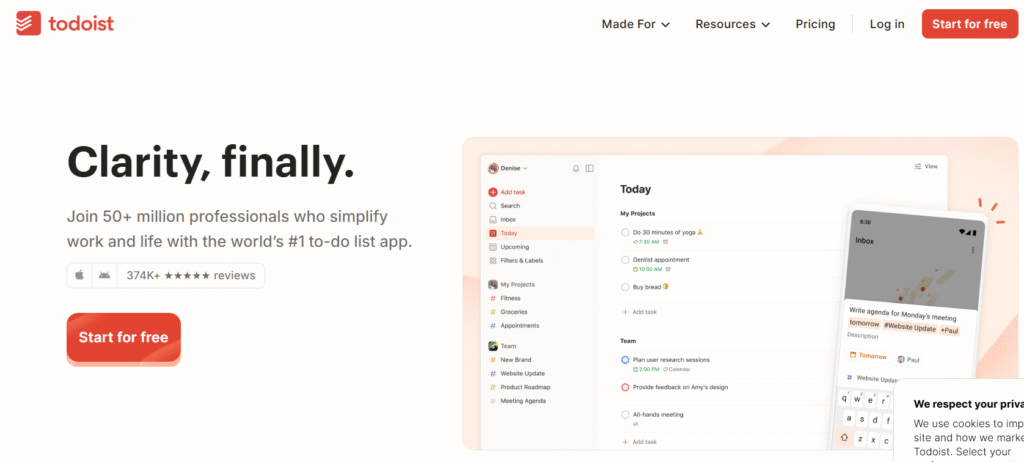12 Tips On How To Work From Home Effectively

Look at this: working from home sounds like a dream until you realise you’ve been in your pyjamas for three days straight, your “office” is the corner of your dining table, and your cat has crashed more Zoom meetings than you care to admit. 🙂
But here’s the thing: remote work isn’t going anywhere. If anything, it’s becoming the new normal, and honestly?
Once you crack the code, you’ll wonder why anyone ever thought commuting two hours daily made sense.
I’ve spent years analysing work-from-home trends (finance degree perks!), and I’ve seen both the success stories and the spectacular failures.
The difference? It’s not about motivation or discipline alone; it’s about creating systems that actually work for real humans, not productivity robots.
So grab your coffee (or third energy drink, no judgment), and let’s talk about how to genuinely thrive while working from home.
Is Working From Home Actually Productive?
Here’s where I get to drop some truth bombs backed by actual data.
Remote workers can be 13-20% more productive than their office-bound counterparts.
I’ve reviewed financial reports from companies like GitLab and Buffer, and the numbers don’t lie.
But, and this is crucial, that productivity boost doesn’t happen automatically.
Think about it this way: when you’re at home, you eliminate the productivity killers that plague traditional offices.
No, Karen from accounting is stopping by your desk for a 30-minute chat about her weekend.
No surprise meetings that could’ve been emails. No open-plan office chaos.
However, you trade those distractions for new ones. Netflix is right there.
Your bed looks extremely inviting at 2 PM. That pile of laundry isn’t going to fold itself (though wouldn’t that be nice?).
The productivity question isn’t “Can you be productive at home?” It’s “Have you set yourself up to be productive at home?” Big difference.
Can You Make A Lot Of Money Working From Home?
Short answer? Absolutely yes.
Long answer? It depends on your approach and financial strategy.
From a pure finance perspective, working remotely opens up income opportunities that traditional employment simply can’t match.
I’m talking about stacking income streams like you’re building an investment portfolio, because essentially, that’s exactly what you’re doing.
Let me break down the money math that makes remote work financially compelling:
Cost savings alone can boost your effective income by 15-30%.
When you eliminate commuting costs (gas, car maintenance, parking fees, or public transit passes), work wardrobes, daily lunch expenses, and coffee runs, you’re looking at $200-500 saved monthly for the average worker.
That’s $2,400-6,000 annually that stays in your pocket.
But here’s where it gets interesting financially: remote work enables multiple income streams.
You can freelance during gaps in your schedule, consult on evenings, or build passive income projects during lunch breaks.
I’ve analysed countless financial profiles of remote workers who’ve doubled their income within two years by strategically adding supplementary revenue streams.
Some freelancers on platforms like Upwork or Fiverr earn six figures annually. Yes, working from their couches.
The key is treating your remote work like a business portfolio: diversify, optimise, and continuously look for better returns on your time investment.
What’s The Best Part Of Working From Home?

IMO, the absolute best part isn’t the lack of commute or the flexible schedule, it’s time sovereignty.
Let me explain what I mean financially. Time is literally money, right? But in traditional employment, you’re selling your time in bulk at a fixed rate.
Eight hours a day, five days a week, for a predetermined salary.
Remote work flips this model. You gain the ability to optimise your time value.
Got a high-priority work task that requires deep focus?
Knock it out during your peak productivity hours (mine’s 6-9 AM, which would be impossible with a traditional office schedule).
Need to handle a personal errand? Shift your schedule slightly.
Want to take a 20-minute power nap because you stayed up late finishing a project? Do it.
This flexibility translates directly into quality of life improvements that have real financial value.
Less stress means fewer health issues (healthcare costs, anyone?).
A better work-life balance means improved mental health.
More control over your schedule means you can pursue side hustles, education, or skill development.
When I calculate the total compensation package of remote work versus traditional employment, these intangible benefits add thousands of dollars in effective value.
Benefits Of Working From Home
Beyond the obvious perks, working from home offers financial and lifestyle advantages that compound over time:
Reduced stress equals better decision-making. When you’re not burned out from office politics and commutes, your cognitive function improves.
Better thinking leads to better work output, which leads to promotions, raises, or better freelance rates.
Geographic arbitrage opportunities. You can live in a low-cost area while earning a salary from a high-cost market.
I’ve seen remote workers living in places with 50% lower cost of living than where their employers are based. That’s an instant quality-of-life upgrade.
Health cost savings. Less commuting stress, more time for exercise, ability to prepare healthy meals these factors that reduce long-term healthcare expenses significantly.
Family dynamics improve. Being present for your kids, partner, or ageing parents isn’t just emotionally valuable; it reduces potential emergency costs and relationship stress.
The financial benefits extend beyond your paycheck. You’re building lifestyle equity.
How To Work Effectively From Home
Let’s get tactical. Effectiveness at home isn’t about hustling harder; it’s about architecting your environment and habits to support productivity.
The biggest mistake I see people make? Treating home like an office. It’s not.
Trying to force office behaviors into a home environment is like trying to fit a square peg in a round hole.
Instead, you need to create a personalized productivity ecosystem.
This means understanding your work patterns, energy cycles, and what genuinely works for your brain.
Time management is obviously crucial, but it’s not just about schedules and calendars.
It’s about understanding your cognitive load capacity, recognising when you’re most creative versus most analytical, and structuring your day accordingly.
Ever notice how some tasks feel effortless at certain times and impossible at others?
That’s not laziness, that’s your circadian rhythm and cognitive patterns at work.
Work with your biology, not against it.
12 Tips On How To Work From Home Effectively
Alright, here’s where we get into the practical strategies that actually move the needle.
These aren’t generic productivity tips; they’re field-tested approaches that acknowledge you’re a real human with distractions, limitations, and yes, occasional motivation issues.
1. Inform Anyone At Home That You’d Be Working From Home
This sounds obvious until you’re on an important client call and your roommate walks in asking where you put the peanut butter. :/
Setting boundaries isn’t rude; it’s essential operational protocol.
Sit down with everyone in your household and have an explicit conversation about your work schedule.
Not a casual “yeah I’ll be working tomorrow”, a detailed discussion about when you’re unavailable, what constitutes an emergency interruption, and what can wait.
I recommend creating a visual signal system. A closed door means “do not disturb unless the house is on fire.” Headphones on? Same deal.
Some people use literal red/green lights outside their workspace.
The financial angle here? Interrupted work means tasks take longer, quality suffers, and you might miss deadlines.
That directly impacts your income security. Think of boundaries as revenue protection.
Also, this conversation should include what you need from your household: quiet during calls, no interruptions during certain hours, support with household tasks, etc.
Remote work is a household adjustment, not just an individual one.
2. Go For Breaks When Necessary

Here’s what productivity gurus won’t tell you: pushing through without breaks doesn’t make you productive; it makes you exhausted.
Your brain operates on ultradian rhythms, roughly 90-minute cycles of high focus followed by a natural energy dip.
Fighting this is like trying to swim against the current. Exhausting and inefficient.
Instead, structure breaks strategically:
- Micro-breaks (5 minutes) every hour: Stand, stretch, look away from screens
- Movement breaks (10-15 minutes) every 2-3 hours: Walk, light exercise, fresh air
- Mental reset breaks (20-30 minutes) mid-day: Lunch, meditation, hobby time
The science backs this up. Studies show that taking regular breaks increases overall productivity by 15-20% compared to pushing through continuously.
From a finance perspective, think about breaks as preventive maintenance on your most valuable asset: your brain.
You wouldn’t run a machine continuously without maintenance. Don’t do it to yourself either.
Plus, breaks reduce burnout, which is financially devastating.
Recovering from burnout can take months and cost thousands in lost income and healthcare expenses.
3. Prepare Meals The Night Before
Meal prep isn’t just for fitness enthusiasts; it’s a financial and productivity strategy.
Here’s the cost-benefit analysis: Spending 1-2 hours Sunday evening preparing meals for the week saves 30-60 minutes daily.
That’s 2.5-5 hours weekly that you can redirect toward work, side projects, or rest.
But the financial impact goes deeper. When you’re hungry and unprepared, you make expensive decisions.
DoorDash for lunch? That’s $15-25 per meal. Five times a week equals $75-125 weekly, or $3,900-6,500 annually.
Contrast that with meal prepping, which typically costs $40-60 weekly for quality ingredients.
You’re saving $2,000-4,500 annually while eating healthier and avoiding the productivity crash from takeout food.
My approach: batch cook proteins and grains on Sunday, prep veggies, portion everything into containers. Breakfast, lunch, and snacks are ready.
Morning routine takes 5 minutes instead of 30.
This also eliminates decision fatigue. One less choice to make daily means more mental energy for actual work.
4. Create A To-Do List

I know, I know, everyone says make a to-do list. But most people do it wrong.
A to-do list isn’t just a random collection of tasks. It’s a strategic prioritisation tool based on impact and effort.
Use the Eisenhower Matrix:
- Urgent and important: Do immediately
- Important but not urgent: Schedule specifically
- Urgent but not important: Delegate or minimize
- Neither urgent nor important: Eliminate
I also recommend time-blocking your to-do list. Don’t just list “write report”, assign it to a specific 2-hour block when you know you’ll have focus.
From a financial planning perspective, treat your to-do list like a project portfolio.
What tasks generate the highest ROI on your time?
Prioritise those. What tasks are low-value time sinks? Eliminate or automate them.
Use digital tools like Todoist or Notion to create dynamic, prioritised lists that sync across devices.
The small productivity boost compounds significantly over months.
5. Eat And Sleep
This seems too basic to mention, but the number of remote workers who neglect fundamental biology is staggering.
Sleep deprivation costs the US economy $411 billion annually in lost productivity.
Individually, chronic sleep debt reduces your cognitive performance by up to 40%. You’re essentially working at 60% capacity.
Think about that financially: if you earn $50,000 annually but operate at 60% cognitive capacity due to poor sleep, you’re performing like someone worth $30,000.
That 40% gap represents lost promotions, raises, and opportunities.
Aim for 7-9 hours of quality sleep. Non-negotiable.
Same with nutrition. Your brain uses 20% of your body’s energy despite being only 2% of your body weight. Feed it properly or watch your productivity tank.
I structure my eating around sustained energy: protein and complex carbs for stable blood sugar, avoiding the crash-and-burn cycle of simple sugars and caffeine.
A 20-minute power nap mid-afternoon? Game changer. NASA found that a 26-minute nap improved pilot performance by 34% and alertness by 54%.
You don’t need to fly planes, but you do need to maintain focus for 6-8 hours.
6. Speak With Your Employer When Necessary

Communication hesitancy costs money.
I’ve analysed performance reviews and termination cases, and a shocking number stem from poor communication rather than poor work.
Remote workers who struggle in silence get blindsided by negative feedback or job loss.
Instead, over-communicate, especially when:
- You’re unclear about expectations or priorities
- A project is going off track
- You need additional resources or support
- Personal issues might affect your availability
Schedule regular check-ins with your manager. Weekly 15-minute syncs prevent bigger problems from developing.
Use these to clarify priorities, share progress, and flag potential issues early.
When you communicate proactively, you’re demonstrating professionalism and protecting your income.
Employers value remote workers who are transparent and solutions-oriented.
Also, document everything. Use Slack, email, or project management tools to create paper trails.
This protects you if questions arise about deliverables or timelines.
7. Work For A Remote-Friendly Company
Not all remote work is created equal, and this matters financially.
Some companies offer “remote work” but maintain office-centric cultures.
You’re technically remote but expected to be available during office hours in a different time zone, attend frequent in-person meetings, or deal with managers who don’t trust remote workers.
These pseudo-remote positions give you remote work’s challenges without its benefits.
Before accepting a remote position, evaluate the company’s remote culture:
- How long have they been remote?
- What percentage of the company works remotely?
- Are senior leadership roles held by remote workers?
- What tools and processes support remote collaboration?
- Do they offer remote-specific benefits (home office stipend, coworking membership)?
True remote-friendly companies understand that remote work requires different management styles, communication norms, and operational structures.
They invest in making remote work successful.
From a career development perspective, working for a remote-native company like GitLab, Automattic, or Buffer provides better long-term growth opportunities than fighting against an office-first culture.
8. Begin A Freelance Career
If you’re new to remote work, freelancing offers the lowest barrier to entry and the highest learning curve.
Here’s why this matters financially:
freelancing teaches you how to manage your own time, communicate with clients remotely, deliver results without supervision, and handle the psychological challenges of working alone.
These skills transfer directly to full-time remote employment.
Plus, freelancing lets you test different niches and roles without committing to a single employer.
You might discover you love something you’d never considered.
Platforms to start:
- Fiverr: Good for beginners, lower rates initially
- Upwork: Larger projects, better long-term client relationships
- Freelancer.com: Competitive bidding system
- Toptal: High-end, requires rigorous screening
Start small. Take a few projects while maintaining other income. Build your skills, portfolio, and confidence.
Many successful remote workers began as freelancers before transitioning to full-time positions or building agencies.
The financial progression looks like this:
Start at $15-25/hour → Build skills and portfolio → Raise rates to $40-75/hour → Specialize and charge $100-200/hour → Eventually offer packages or retainers worth thousands monthly.
9. Start Early
Morning routines aren’t just for self-help enthusiasts; they’re productivity multipliers with compounding effects.
Research shows that willpower and decision-making capacity are highest in the morning and decline throughout the day.
By starting your most important, cognitively demanding work early, you’re tackling it when your brain operates at peak capacity.
I start work by 7 AM, which seems crazy to some people. But by 10 AM, I’ve already completed 3 hours of deep work on high-priority projects.
The rest of the day is meetings, emails, and lighter tasks.
Starting early also creates a psychological advantage: you’re ahead before most people have started.
This momentum carries through the entire day.
Plus, early mornings are generally quieter. Fewer emails, fewer Slack messages, fewer distractions.
It’s like having a secret productive hour before the chaos begins.
If you’re not naturally a morning person, gradually shift your schedule. Start 15 minutes earlier weekly until you reach your target time.
Pair this with consistent sleep schedules to adjust your circadian rhythm.
10. Avoid Using Social Media
Let’s be brutally honest: social media is designed to hijack your attention and monetise it.
Every time you “just quickly check” Instagram or Twitter, you’re triggering a 20-minute productivity loss.
Not because you spend 20 minutes scrolling (though you might), but because it takes that long to regain deep focus after an interruption.
Do that five times daily? You’ve lost 100 minutes of productive time. Over a year, that’s 433 hours, nearly 11 full work weeks.
The financial cost? If you earn $25/hour, that’s $10,825 annually lost to social media distractions. At $50/hour? $21,650.
My approach: completely remove social media apps from my phone during work hours.
No Instagram, no Twitter, no TikTok. If I need to post something for work, I use desktop web versions, which are deliberately less engaging.
I also use website blockers like Freedom or Cold Turkey to prevent casual browsing during work blocks.
Save social media for designated break times or after work. You’ll be shocked at how much more you accomplish.
11. Set Milestones
Goal-setting psychology is fascinating: breaking large goals into smaller milestones increases completion rates by 30-50%.
Instead of “complete project by Friday,” set daily milestones: “Monday: outline sections; Tuesday: write introduction and section 1; Wednesday: complete sections 2-3” and so on.
This approach provides:
- Frequent wins: Each completed milestone releases dopamine, reinforcing productive behaviour
- Progress visibility: You can see advancement, preventing the “I’m not getting anywhere” feeling
- Early problem detection: If you miss Tuesday’s milestone, you know Friday’s deadline is at risk, and you can adjust
I also attach mini-rewards to milestones. Complete a challenging task? Take a 15-minute walk. Finish a major project section? Watch a favourite show during lunch.
These small rewards create positive associations with productive work, making it psychologically easier to maintain momentum.
From a financial perspective, hitting milestones consistently improves your reputation with employers or clients, leading to better projects, higher rates, and more opportunities.
12. Save Calls For Later
Phone calls are one of the most underestimated productivity killers in remote work.
Each unexpected call interrupts your flow state, requires context switching, and often introduces new information that derails your planned schedule.
Even a 5-minute call can cost 25 minutes of productive time.
My rule: unless someone’s dying or there’s an urgent work crisis, calls wait until designated times.
I set specific “communication windows”: 11 AM-12 PM and 3 PM-4 PM daily.
During these times, I’m available for calls, messages, and real-time communication. Outside these windows, I’m in focus mode.
Use status messages in Slack or Teams to communicate your availability.
Set your phone to Do Not Disturb during deep work blocks (most phones allow exceptions for emergency contacts).
For work calls, always schedule them in advance. This gives you time to prepare, ensures the call fits your schedule, and eliminates the chaos of random interruptions.
Emergency calls? They’re rare. Most things that feel urgent aren’t actually urgent.
Learning to distinguish true emergencies from manufactured urgency is a crucial remote work skill.
Work From Home Advantages And Disadvantages
Let’s talk real talk about the full picture, because sugarcoating doesn’t help anyone make good decisions.
Advantages
Time and money savings: Eliminating commutes saves 200-400 hours annually, plus $2,000-7,000 in transportation costs. That’s substantial.
Income diversification potential: Multiple income streams become feasible when you control your schedule, dramatically increasing your financial security.
Geographic flexibility: Live where you want, not where your job is. This enables massive cost-of-living arbitrage opportunities.
Health improvements: More sleep, better nutrition, reduced stress, and more exercise time; these compound into significant long-term health benefits and reduced healthcare costs.
Family presence: Being available for kids, partners, and parents isn’t just emotionally valuable; it’s economically valuable when you calculate eldercare costs or childcare savings.
Customised environment: Work in the conditions that optimise your productivity, whether that’s complete silence, background music, or frequent movement.
Disadvantages
Social isolation: Humans are social creatures. Remote work can be lonely, potentially affecting mental health and job satisfaction.
Blurred boundaries: When your home is your office, it’s harder to “leave work” mentally. This can lead to overwork and burnout.
Career visibility concerns: “Out of sight, out of mind” is real. Remote workers sometimes get overlooked for promotions or high-profile projects.
Self-discipline requirements: Without external structure, you must create your own. Not everyone excels at this.
Communication challenges: Remote communication requires more deliberate effort. Misunderstandings happen more easily without an in-person context.
Limited job availability in some fields: Not all industries or roles can be done remotely. You might need to switch careers or specialise differently.
Home infrastructure costs: You need reliable internet, an appropriate workspace, and possibly upgraded tech costs that employers don’t always cover.
Being honest about both sides helps you prepare appropriately rather than getting blindsided by challenges.
Final Thoughts
Working from home isn’t a magic fix, but it’s far from a fantasy. It’s a real career setup that demands the right skills, discipline, and environment.
The people who thrive remotely don’t just “wing it”; they build systems that support focus, balance, and productivity.
Financially, remote work can be a game-changer, fewer expenses, more income streams, and the freedom to live where your money stretches further.
But success takes effort: set clear boundaries, build routines, communicate well, and manage your energy intentionally.
You’ll still have unproductive days and moments of doubt, and that’s okay. Progress comes from consistency, not perfection.
Start with one or two tips, apply them for a month, then build from there. The future of work is flexible; master it now, and you’ll be ready to thrive.








